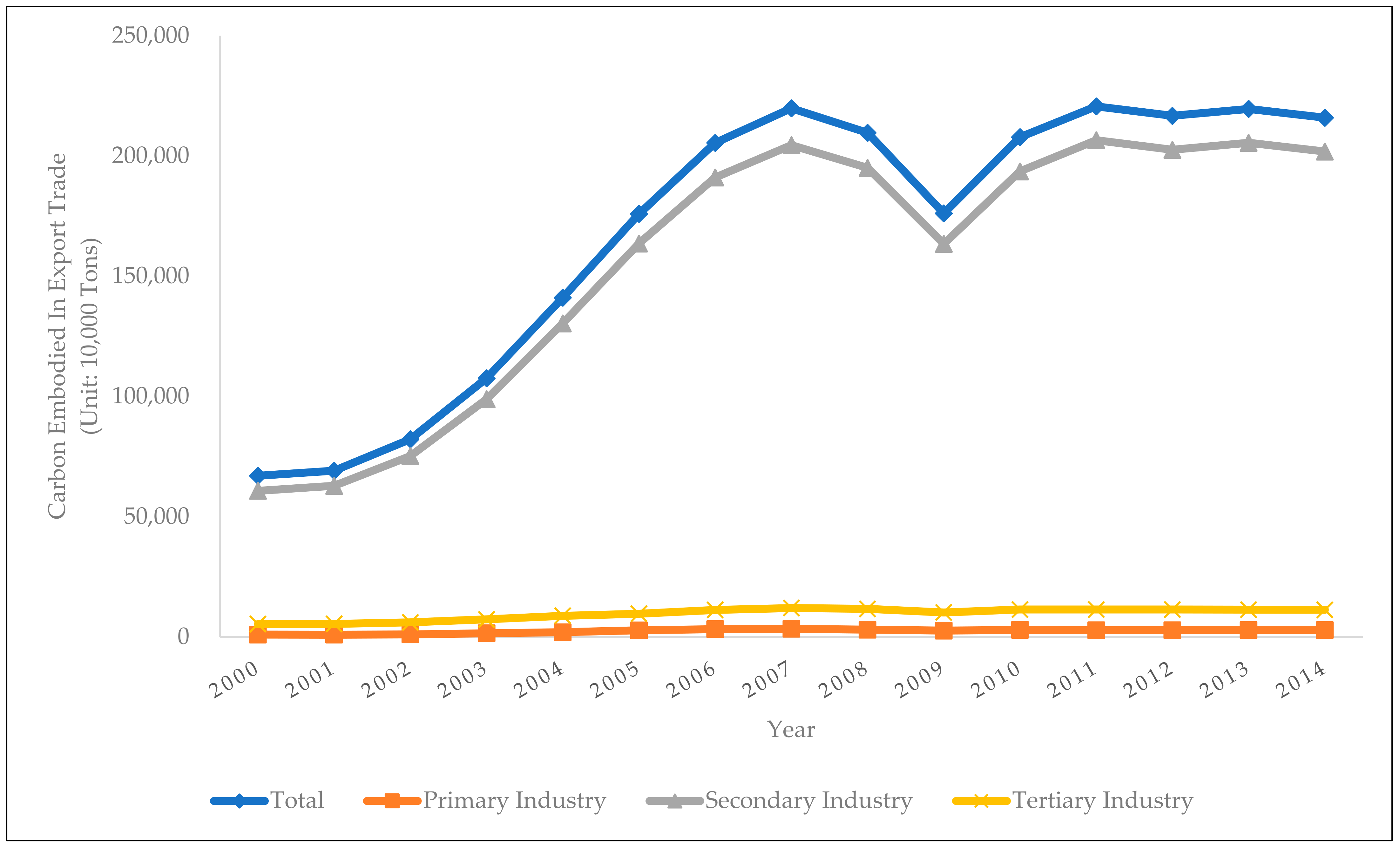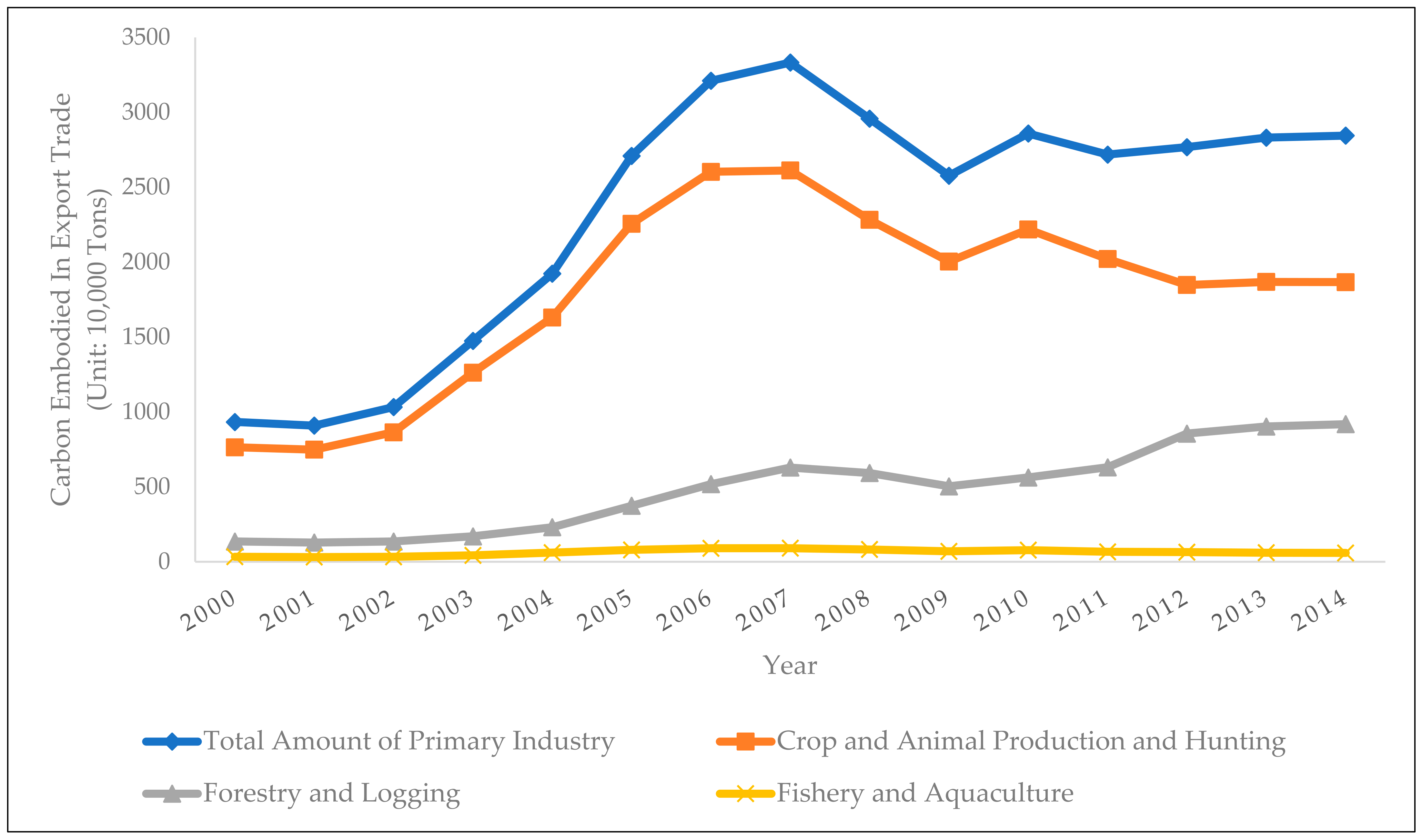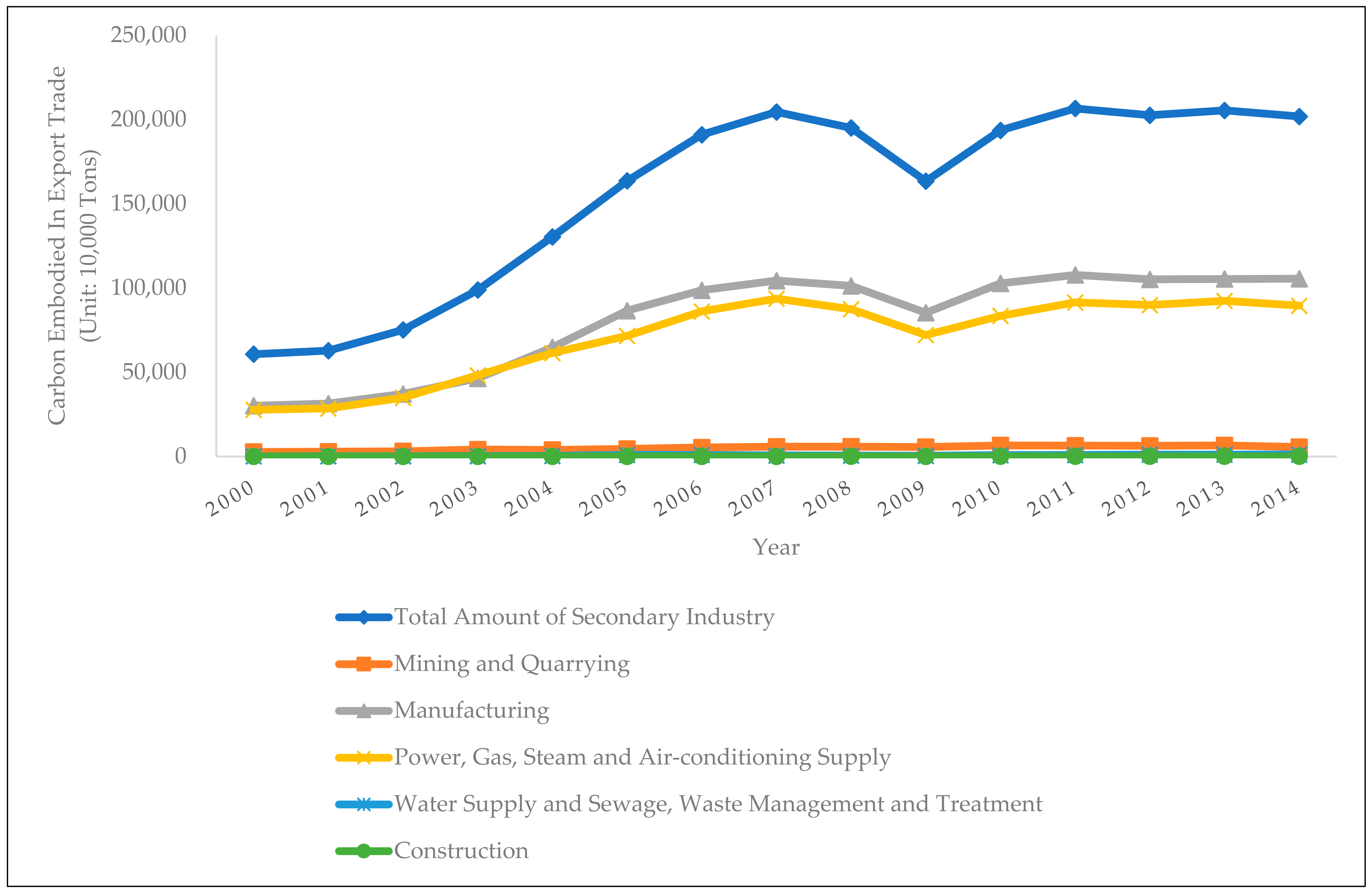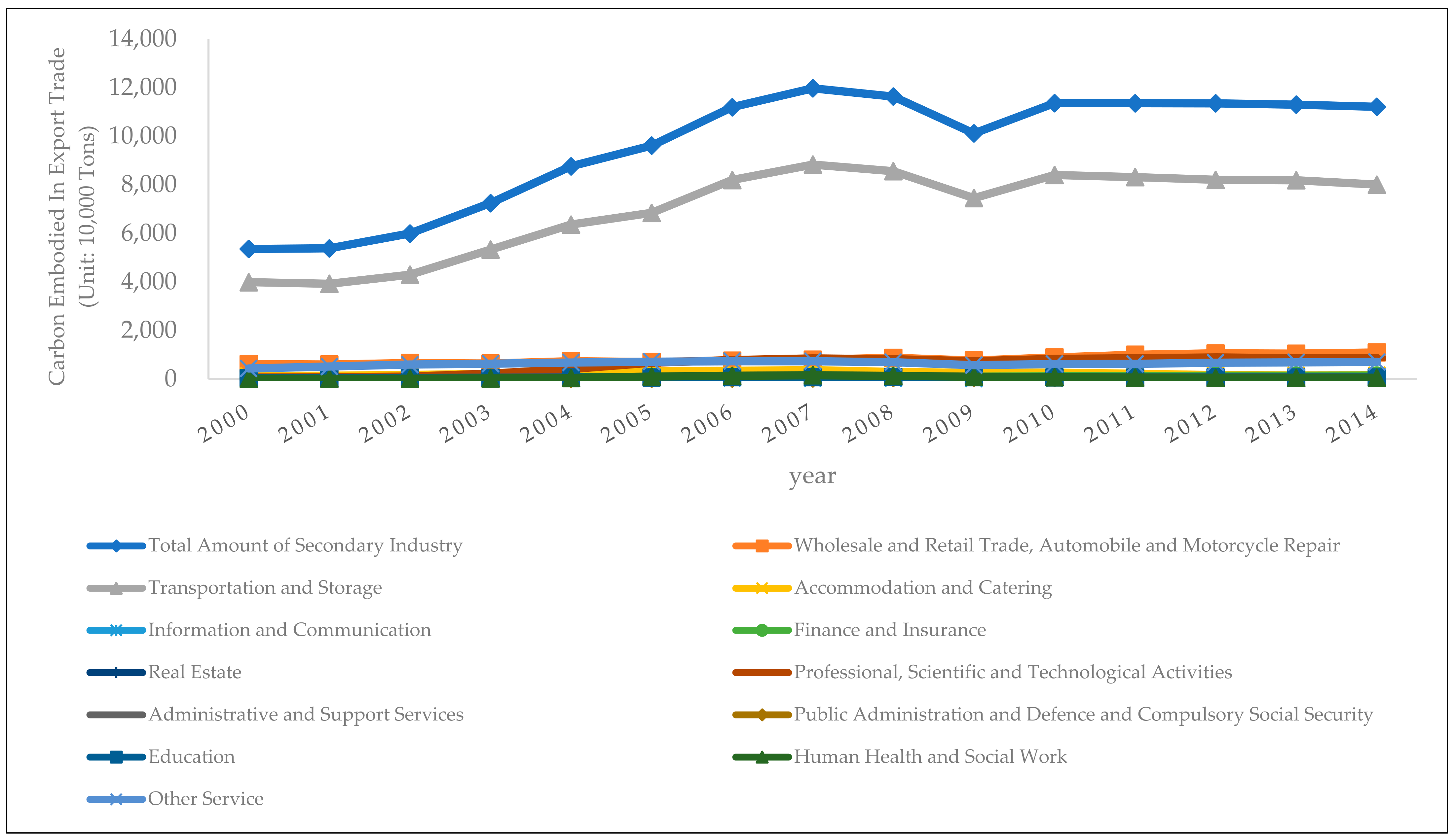Embodied Carbon in China’s Export Trade: A Multi Region Input-Output Analysis
Abstract
:1. Introduction
2. Materials and Methods
2.1. Input-Output Analysis Method
2.2. Calculation Model of Trade Embodied Carbon
2.3. Data Source and Calculation Process
3. Results and Discussion
3.1. Analysis of the Calculation Results of the Total Embodied Carbon in China’s Export Trade
3.2. Analysis of Embodied Carbon in Export Trade of the Primary Industry
3.3. Analysis of Embodied Carbon in Export Trade of the Secondary Industry
3.4. Analysis of Embodied Carbon in Export Trade of the Tertiary Industry
4. Conclusions and Policy Recommendations
Author Contributions
Funding
Institutional Review Board Statement
Informed Consent Statement
Data Availability Statement
Conflicts of Interest
References
- Majeed, A.; Wang, L.; Zhang, X.; Muniba; Kirikkaleli, D. Modeling the dynamic links among natural resources, economic globalization, disaggregated energy consumption, and environmental quality: Fresh evidence from GCC economies. Resour. Policy 2021, 73, 102204. [Google Scholar] [CrossRef]
- Lu, S.; Zhao, Y.; Chen, Z.; Dou, M.; Zhang, Q.; Yang, W. Association between Atrial Fibrillation Incidence and Temperatures, Wind Scale and Air Quality: An Exploratory Study for Shanghai and Kunming. Sustainability 2021, 13, 5247. [Google Scholar] [CrossRef]
- Xia, W.; Apergis, N.; Bashir, M.F.; Ghosh, S.; Doğan, B.; Shahzad, U. Investigating the role of globalization, and energy consumption for environmental externalities: Empirical evidence from developed and developing economies. Renew. Energy 2022, 183, 219–228. [Google Scholar] [CrossRef]
- Marino, R.; Atzori, A.S.; D’Andrea, M.; Iovane, G.; Trabalza Marinucci, M.; Rinaldi, L. Climate change: Production performance, health issues, greenhouse gas emissions and mitigation strategies in sheep and goat farming. Small Rumin. Res. 2016, 135, 50–59. [Google Scholar] [CrossRef]
- Dino, I.G.; Akgül, C.M. Impact of climate change on the existing residential building stock in Turkey: An analysis on energy use, greenhouse gas emissions and occupant comfort. Renew. Energy 2019, 141, 828–846. [Google Scholar] [CrossRef]
- Yang, W.; Yuan, G.; Han, J. Is China’s air pollution control policy effective? Evidence from Yangtze River Delta cities. J. Clean. Prod. 2019, 220, 110–133. [Google Scholar] [CrossRef]
- Bodansky, D.; Lawrence, J.C. Trade and Environment. In The Oxford Handbook of International Trade Law; Oxford University Press: Oxford, UK, 2012; ISBN 9780199231928. [Google Scholar]
- McAusland, C.; Millimet, D.L. Do national borders matter? Intranational trade, international trade, and the environment. J. Environ. Econ. Manag. 2013, 65, 411–437. [Google Scholar] [CrossRef] [Green Version]
- Shahbaz, M.; Hye, Q.M.A.; Tiwari, A.K.; Leitão, N.C. Economic growth, energy consumption, financial development, international trade and CO2 emissions in Indonesia. Renew. Sustain. Energy Rev. 2013, 25, 109–121. [Google Scholar] [CrossRef] [Green Version]
- Müller Casseres, E.; Edelenbosch, O.Y.; Szklo, A.; Schaeffer, R.; van Vuuren, D.P. Global futures of trade impacting the challenge to decarbonize the international shipping sector. Energy 2021, 237, 121547. [Google Scholar] [CrossRef]
- Ortiz, A.M.D.; Outhwaite, C.L.; Dalin, C.; Newbold, T. A review of the interactions between biodiversity, agriculture, climate change, and international trade: Research and policy priorities. One Earth 2021, 4, 88–101. [Google Scholar] [CrossRef]
- Yang, W.; Gao, H.; Yang, Y. Analysis of Influencing Factors of Embodied Carbon in China’s Export Trade in the Background of “Carbon Peak” and “Carbon Neutrality”. Sustainability 2022, 14, 3308. [Google Scholar] [CrossRef]
- Nabeshima, K.; Obashi, A. Impact of Regulatory Burdens on International Trade. J. Jpn. Int. Econ. 2021, 59, 101120. [Google Scholar] [CrossRef]
- Haldar, A.; Sethi, N. Environmental effects of Information and Communication Technology-Exploring the roles of renewable energy, innovation, trade and financial development. Renew. Sustain. Energy Rev. 2022, 153, 111754. [Google Scholar] [CrossRef]
- Kim, T.; Tromp, N. Analysis of carbon emissions embodied in South Korea’s international trade: Production-based and consumption-based perspectives. J. Clean. Prod. 2021, 320, 128839. [Google Scholar] [CrossRef]
- Yang, W.X.; Li, L.G. Energy Efficiency, Ownership Structure, and Sustainable Development: Evidence from China. Sustainability 2017, 9, 912. [Google Scholar] [CrossRef] [Green Version]
- Feng, R.; Shen, C.; Huang, L.; Tang, X. Does trade in services improve carbon efficiency? —Analysis based on international panel data. Technol. Forecast. Soc. Chang. 2022, 174, 121298. [Google Scholar] [CrossRef]
- Yang, W.; Li, L. Efficiency evaluation of industrial waste gas control in China: A study based on data envelopment analysis (DEA) model. J. Clean. Prod. 2018, 179, 1–11. [Google Scholar] [CrossRef]
- Yuan, G.; Yang, W. Evaluating China’s air pollution control policy with extended AQI indicator system: Example of the Beijing-Tianjin-Hebei Region. Sustainability 2019, 11, 939. [Google Scholar] [CrossRef] [Green Version]
- Yang, Y.; Yang, W. Does Whistleblowing Work for Air Pollution Control in China? A Study Based on Three-party Evolutionary Game Model under Incomplete Information. Sustainability 2019, 11, 324. [Google Scholar] [CrossRef] [Green Version]
- Gao, H.; Yang, W.; Wang, J.; Zheng, X. Analysis of the Effectiveness of Air Pollution Control Policies based on Historical Evaluation and Deep Learning Forecast: A Case Study of Chengdu-Chongqing Region in China. Sustainability 2021, 13, 206. [Google Scholar] [CrossRef]
- Khajehpour, H.; Saboohi, Y.; Tsatsaronis, G. On the fair accounting of carbon emissions in the global system using an exergy cost formation concept. J. Clean. Prod. 2021, 280, 124438. [Google Scholar] [CrossRef]
- Banerjee, S.; Khan, M.A.; ul Husnain, M.I. Searching appropriate system boundary for accounting India’s emission inventory for the responsibility to reduce carbon emissions. J. Environ. Manag. 2021, 295, 112907. [Google Scholar] [CrossRef]
- Jakob, M.; Ward, H.; Steckel, J.C. Sharing responsibility for trade-related emissions based on economic benefits. Glob. Environ. Chang. 2021, 66, 102207. [Google Scholar] [CrossRef]
- Minunno, R.; O’Grady, T.; Morrison, G.M.; Gruner, R.L. Investigating the embodied energy and carbon of buildings: A systematic literature review and meta-analysis of life cycle assessments. Renew. Sustain. Energy Rev. 2021, 143, 110935. [Google Scholar] [CrossRef]
- Grote, M.; Williams, I.; Preston, J. Direct carbon dioxide emissions from civil aircraft. Atmos. Environ. 2014, 95, 214–224. [Google Scholar] [CrossRef]
- Meng, W.; Xu, L.; Hu, B.; Zhou, J.; Wang, Z. Quantifying direct and indirect carbon dioxide emissions of the Chinese tourism industry. J. Clean. Prod. 2016, 126, 586–594. [Google Scholar] [CrossRef]
- Kim, Y.; Lim, J. Treatment of indirect emissions from the power sector in Korean emissions trading system. Environ. Econ. Policy Stud. 2021, 23, 581–592. [Google Scholar] [CrossRef]
- Schulz, N.B. Delving into the carbon footprints of Singapore—Comparing direct and indirect greenhouse gas emissions of a small and open economic system. Energy Policy 2010, 38, 4848–4855. [Google Scholar] [CrossRef]
- Sato, M. Embodied Carbon in Trade: A Survey of the Empirical Literature. J. Econ. Surv. 2014, 28, 831–861. [Google Scholar] [CrossRef]
- Arce, G.; López, L.A.; Guan, D. Carbon emissions embodied in international trade: The post-China era. Appl. Energy 2016, 184, 1063–1072. [Google Scholar] [CrossRef]
- Liu, Q.; Zhu, Y.; Yang, W.; Wang, X. Research on the Impact of Environmental Regulation on Green Technology Innovation from the Perspective of Regional Dif-ferences: A Quasi-natural Experiment Based on China’s New Environmental Protection Law. Sustainability 2022, 14, 1714. [Google Scholar] [CrossRef]
- Sakai, M.; Barrett, J. Border carbon adjustments: Addressing emissions embodied in trade. Energy Policy 2016, 92, 102–110. [Google Scholar] [CrossRef] [Green Version]
- Gao, H.; Yang, W.; Yang, Y.; Yuan, G. Analysis of the air quality and the effect of governance policies in China’s Pearl River Delta, 2015–2018. Atmosphere 2019, 10, 412. [Google Scholar] [CrossRef] [Green Version]
- Yang, W.; Yang, Y. Research on Air Pollution Control in China: From the Perspective of Quadrilateral Evolutionary Games. Sustainability 2020, 12, 1756. [Google Scholar] [CrossRef] [Green Version]
- Shen, X.; Yang, W.; Sun, S. Analysis of the impact of China’s hierarchical medical system and online appointment diagnosis system on the sustainable development of public health: A case study of Shanghai. Sustainability 2019, 11, 6564. [Google Scholar] [CrossRef] [Green Version]
- Leontief, W. Environmental repercussions and the economic structure: An input-output approach. Rev. Econ. Stat. 1970, 52, 262–271. [Google Scholar] [CrossRef]
- Huang, L.; Zhao, X. Impact of financial development on trade-embodied carbon dioxide emissions: Evidence from 30 provinces in China. J. Clean. Prod. 2018, 198, 721–736. [Google Scholar] [CrossRef]
- Dietzenbacher, E.; Pei, J.; Yang, C. Trade, production fragmentation, and China’s carbon dioxide emissions. J. Environ. Econ. Manag. 2012, 64, 88–101. [Google Scholar] [CrossRef]
- Weber, C.L.; Peters, G.P. Climate change policy and international trade: Policy considerations in the US. Energy Policy 2009, 37, 432–440. [Google Scholar] [CrossRef]
- Wang, Z.; Li, Y.; Cai, H.; Yang, Y.; Wang, B. Regional difference and drivers in China’s carbon emissions embodied in internal trade. Energy Econ. 2019, 83, 217–228. [Google Scholar] [CrossRef]
- Sun, C.; Ding, D.; Yang, M. Estimating the complete CO2 emissions and the carbon intensity in India: From the carbon transfer perspective. Energy Policy 2017, 109, 418–427. [Google Scholar] [CrossRef]
- Qian, Z.; Yang, L.; Jiang, Q. The Measurement and Structural Decomposition of Implied Carbon in China’s Export Value Added in the Context of Global Value Chains. Asia-Pac. Econ. Rev. 2019, 5, 59–67, 150–151. (In Chinese) [Google Scholar]
- Hu, J.; Ren, X.; Gao, P. Research on the Measurement of China’s Inter-provincial Trade, International Trade and Low Carbon Trade Competitiveness. J. Quant. Tech. Econ. 2019, 36, 42–60. (In Chinese) [Google Scholar]
- Qu, S.; Cai, H.; Xu, D.; Mohamed, N. Uncertainty in the prediction and management of CO2 emissions: A robust minimum entropy approach. Nat. Hazards 2021, 107, 2419–2438. [Google Scholar] [CrossRef]
- Liu, Y. Analysis of Embodied CO2 Emissions in China’s Bilateral Trade: A Processing Trade Differentiated Non-Competitive Import Input-Output Approach. Financ. Trade Econ. 2015, 5, 96–108. (In Chinese) [Google Scholar]
- Wiedmann, T.; Lenzen, M.; Turner, K.; Barrett, J. Examining the global environmental impact of regional consumption activities—Part 2: Review of input–output models for the assessment of environmental impacts embodied in trade. Ecol. Econ. 2007, 61, 15–26. [Google Scholar] [CrossRef]
- Jensen, C.D.; Mcintyre, S.; Munday, M.; Turner, K. Responsibility for Regional Waste Generation: A Single-Region Extended Input–Output Analysis for Wales. Reg. Stud. 2013, 47, 913–933. [Google Scholar] [CrossRef] [Green Version]
- Meyer, D.E.; Li, M.; Ingwersen, W.W. Analyzing economy-scale solid waste generation using the United States environmentally-extended input-output model. Resour. Conserv. Recycl. 2020, 157, 104795. [Google Scholar] [CrossRef]
- Towa, E.; Zeller, V.; Achten, W.M.J. Input-output models and waste management analysis: A critical review. J. Clean. Prod. 2020, 249, 119359. [Google Scholar] [CrossRef]
- Valodka, I.; Snieška, V.; Mihi Ramirez, A. Impact of the international trade on the EU clothing industry carbon emissions. Eng. Econ. 2020, 31, 314–322. [Google Scholar] [CrossRef]
- Bolea, L.; Duarte, R.; Sánchez Chóliz, J. Exploring carbon emissions and international inequality in a globalized world: A multiregional-multisectoral perspective. Resour. Conserv. Recycl. 2020, 152, 104516. [Google Scholar] [CrossRef]
- Kanemoto, K.; Shigetomi, Y.; Hoang, N.T.; Okuoka, K.; Moran, D. Spatial variation in household consumption-based carbon emission inventories for 1200 Japanese cities. Environ. Res. Lett. 2020, 15, 114053. [Google Scholar] [CrossRef]
- Carrasco, I.; Castillo Valero, J.S.; Córcoles, C.; Carchano, M. Greening Wine Exports? Changes in the Carbon Footprint of Spanish Wine Exports. Int. J. Environ. Res. Public Health 2021, 18, 9035. [Google Scholar] [CrossRef]
- Osei Owusu, A.K.; Wood, R.; Bjelle, E.L.; Caro, D.; Thomsen, M. Understanding the trends in Denmark’s global food trade-related greenhouse gas and resource footprint. J. Clean. Prod. 2021, 313, 127785. [Google Scholar] [CrossRef]
- Boero, R.; Edwards, B.K.; Rivera, M.K. Regional input–output tables and trade flows: An integrated and interregional non-survey approach. Reg. Stud. 2018, 52, 225–238. [Google Scholar] [CrossRef]
- Sun, Y.; Cadarso, M.A.; Driml, S. Tourism carbon footprint inventories: A review of the environmentally extended input-output approach. Ann. Tour. Res. 2020, 82, 102928. [Google Scholar] [CrossRef]
- Cimpan, C.; Bjelle, E.L.; Strømman, A.H. Plastic packaging flows in Europe: A hybrid input-output approach. J. Ind. Ecol. 2021, 25, 1572–1587. [Google Scholar] [CrossRef]
- Wang, P.P.; Li, Y.P.; Huang, G.H.; Wang, S.G.; Suo, C.; Ma, Y. A multi-scenario factorial analysis and multi-regional input-output model for analyzing CO2 emission reduction path in Jing-Jin-Ji region. J. Clean. Prod. 2021, 300, 126782. [Google Scholar] [CrossRef]
- Zha, D.; Chen, Q.; Wang, L. Exploring carbon rebound effects in Chinese households’ consumption: A simulation analysis based on a multi-regional input–output framework. Appl. Energy 2022, 313, 118847. [Google Scholar] [CrossRef]
- Wang, Q.; Jiang, F.; Li, R. Assessing supply chain greenness from the perspective of embodied renewable energy–A data envelopment analysis using multi-regional input-output analysis. Renew. Energy 2022, in press. [Google Scholar] [CrossRef]
- Leontief, W. Sructure of the world economy: Outline of a simple input-output formulation. Am. Econ. Rev. 1974, 64, 823–834. [Google Scholar]
- Yang, W.; Li, L. Analysis of Total Factor Efficiency of Water Resource and Energy in China: A Study Based on DEA-SBM Model. Sustainability 2017, 9, 1316. [Google Scholar] [CrossRef] [Green Version]
- Montibeler, E.E.; de Oliveira, D.R.; Cordeiro, D.R. Fundamental economic variables: A study from the leontief methodology. EconomiA 2018, 19, 377–394. [Google Scholar] [CrossRef]
- Wang, Y.; Wang, N. Exploring the role of the fisheries sector in China’s national economy: An input–output analysis. Fish. Res. 2021, 243, 106055. [Google Scholar] [CrossRef]
- Wang, S.; Zhao, Y.; Wiedmann, T. Carbon emissions embodied in China–Australia trade: A scenario analysis based on input–output analysis and panel regression models. J. Clean. Prod. 2019, 220, 721–731. [Google Scholar] [CrossRef]
- Wu, X.D.; Guo, J.L.; Li, C.; Chen, G.Q.; Ji, X. Carbon emissions embodied in the global supply chain: Intermediate and final trade imbalances. Sci. Total Environ. 2020, 707, 134670. [Google Scholar] [CrossRef]
- Zhu, K.; Guo, X.; Zhang, Z. Reevaluation of the carbon emissions embodied in global value chains based on an inter-country input-output model with multinational enterprises. Appl. Energy 2022, 307, 118220. [Google Scholar] [CrossRef]
- Lenzen, M.; Pade, L.-L.; Munksgaard, J. CO2 Multipliers in Multi-region Input-Output Models. Econ. Syst. Res. 2004, 16, 391–412. [Google Scholar] [CrossRef]
- Faturay, F.; Vunnava, V.S.G.; Lenzen, M.; Singh, S. Using a new USA multi-region input output (MRIO) model for assessing economic and energy impacts of wind energy expansion in USA. Appl. Energy 2020, 261, 114141. [Google Scholar] [CrossRef]
- Islam, K.M.N.; Kenway, S.J.; Renouf, M.A.; Wiedmann, T.; Lam, K.L. A multi-regional input-output analysis of direct and virtual urban water flows to reduce city water footprints in Australia. Sustain. Cities Soc. 2021, 75, 103236. [Google Scholar] [CrossRef]
- Parikh, A. Various definitions of direct and indirect requirements in input-output analysis. Rev. Econ. Stat. 1975, 57, 375–377. [Google Scholar] [CrossRef]
- University of Groningen. World Input-Output Database. Available online: https://www.rug.nl/ggdc/valuechain/wiod/?lang=en (accessed on 18 January 2022).
- Organization for Economic Cooperation and Development. Input-Output Tables (IOTs). Available online: https://www.oecd.org/sti/ind/input-outputtables.htm (accessed on 18 January 2022).
- Center for Global Trade Analysis. Global Trade Analysis Project. Available online: https://www.gtap.agecon.purdue.edu/databases/v10/index.aspx (accessed on 18 January 2022).
- Asian Development Bank. Input-Output Tables and Analysis. Available online: https://data.adb.org/taxonomy/term/211 (accessed on 18 January 2022).
- Lenzen, M.; Moran, D.; Kanemoto, K.; Geschke, A. Building Eora: A Global Multi-Region Input-output Database at High Country and Sector Resolution. Econ. Syst. Res. 2013, 25, 20–49. [Google Scholar] [CrossRef]
- University of Groningen. WIOD 2016 Release. Available online: https://www.rug.nl/ggdc/valuechain/wiod/wiod-2016-release (accessed on 18 January 2022).
- Corsatea, T.; Lindner, S.; Arto, I.; Roman, M.; Rueda Cantuche, J.; Velazquez Afonso, A.; De Amores Hernandez, A.; Neuwahl, F. World Input-Output Database Environmental Accounts. Available online: https://publications.jrc.ec.europa.eu/repository/handle/JRC116234 (accessed on 18 January 2022).
- Yang, Y.; Yang, W.; Chen, H.; Li, Y. China’s energy whistleblowing and energy supervision policy: An evolutionary game perspective. Energy 2020, 213, 118774. [Google Scholar] [CrossRef]
- Li, L.; Yang, W. Total Factor Efficiency Study on China’s Industrial Coal Input and Wastewater Control with Dual Target Variables. Sustainability 2018, 10, 2121. [Google Scholar] [CrossRef] [Green Version]
- Yang, W.; Li, L. Efficiency Evaluation and Policy Analysis of Industrial Wastewater Control in China. Energies 2017, 10, 1201. [Google Scholar] [CrossRef]
- Jiang, B.; Li, Y.; Yang, W. Evaluation and Treatment Analysis of Air Quality Including Particulate Pollutants: A Case Study of Shandong Province, China. Int. J. Environ. Res. Public Health 2020, 17, 9476. [Google Scholar] [CrossRef]
- Yuan, G.; Yang, W. Study on optimization of economic dispatching of electric power system based on Hybrid Intelligent Algorithms (PSO and AFSA). Energy 2019, 183, 926–935. [Google Scholar] [CrossRef]
- Li, Y.; Yang, W.; Shen, X.; Yuan, G.; Wang, J. Water environment management and performance evaluation in central China: A research based on comprehensive evaluation system. Water 2019, 11, 2472. [Google Scholar] [CrossRef] [Green Version]
- Liu, H.; Liu, J.; Yang, W.; Chen, J.; Zhu, M. Analysis and Prediction of Land Use in Beijing-Tianjin-Hebei Region: A Study Based on the Improved Convolutional Neural Network Model. Sustainability 2020, 12, 3002. [Google Scholar] [CrossRef] [Green Version]
- UNFCCC. United Nations Framework Convention on Climate Change. Available online: https://unfccc.int/ (accessed on 18 January 2022).
- UNFCCC. What Is the Kyoto Protocol? Available online: https://unfccc.int/kyoto_protocol (accessed on 18 January 2022).
- Ministry of Finance of the People’s Republic of China. Start Carbon Trading and Release New Dividends-Shenzhen Pilots China’s First Carbon Emission Rights Exchange. Available online: http://www.mof.gov.cn/zhengwuxinxi/caijingshidian/renminwang/201306/t20130618_925455.htm (accessed on 18 January 2022).
- General Office of the National Development and Reform Commission. Notice of the General Office of the National Development and Reform Commission on Carrying out the Pilot Work of Carbon Emissions Trading. Available online: https://zfxxgk.ndrc.gov.cn/web/iteminfo.jsp?id=1349 (accessed on 18 January 2022).




| Output | Intermediate Demand | Final Demand | Total Output | |||||||
|---|---|---|---|---|---|---|---|---|---|---|
| Input | 1 | 2 | … | M | 1 | 2 | … | M | ||
| Intermediate Input | 1 | Z11 | Z12 | … | Z1M | F11 | F12 | … | F1M | X1 |
| 2 | Z21 | Z22 | … | Z2M | F21 | F22 | … | F2M | X2 | |
| … | … | … | … | … | … | … | … | … | … | |
| M | ZM1 | ZM2 | … | ZMM | FM1 | FM2 | … | FMM | XM | |
| Initial Input | I1 | I2 | … | IM | _ | _ | _ | _ | _ | |
| Total Input | Y1 | Y2 | … | YM | _ | _ | _ | _ | _ | |
Publisher’s Note: MDPI stays neutral with regard to jurisdictional claims in published maps and institutional affiliations. |
© 2022 by the authors. Licensee MDPI, Basel, Switzerland. This article is an open access article distributed under the terms and conditions of the Creative Commons Attribution (CC BY) license (https://creativecommons.org/licenses/by/4.0/).
Share and Cite
Yang, W.; Gao, H.; Yang, Y.; Liao, J. Embodied Carbon in China’s Export Trade: A Multi Region Input-Output Analysis. Int. J. Environ. Res. Public Health 2022, 19, 3894. https://doi.org/10.3390/ijerph19073894
Yang W, Gao H, Yang Y, Liao J. Embodied Carbon in China’s Export Trade: A Multi Region Input-Output Analysis. International Journal of Environmental Research and Public Health. 2022; 19(7):3894. https://doi.org/10.3390/ijerph19073894
Chicago/Turabian StyleYang, Weixin, Hao Gao, Yunpeng Yang, and Jiacheng Liao. 2022. "Embodied Carbon in China’s Export Trade: A Multi Region Input-Output Analysis" International Journal of Environmental Research and Public Health 19, no. 7: 3894. https://doi.org/10.3390/ijerph19073894
APA StyleYang, W., Gao, H., Yang, Y., & Liao, J. (2022). Embodied Carbon in China’s Export Trade: A Multi Region Input-Output Analysis. International Journal of Environmental Research and Public Health, 19(7), 3894. https://doi.org/10.3390/ijerph19073894






